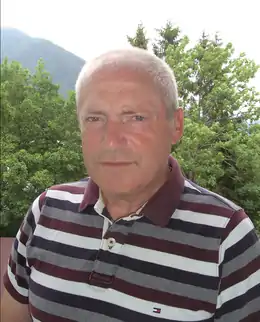Boris Kerner
Boris Kerner est un ingénieur allemand expert en systèmes intelligents de transports. Il est l'auteur d'une théorie alternative controversée de la modélisation du trafic routier, la théorie des trois phases du trafic.

| Naissance | |
|---|---|
| Nationalité | |
| Activités |
| A travaillé pour |
|---|
Biographie
Boris S. Kerner est né à Moscou en 1947. Diplômé en 1972 de l'institut de radioélectricité MIREA à Moscou, il travaille entre 1972 et 1992 en Russie sur la physique des semi-conducteurs, du plasma et la physique des états solides. Il émigre en 1992 vers l'Allemagne où il travaille pour Daimler à Stuttgart. Il s'intéresse au trafic routier et met au point entre 1996 et 2002 sa théorie[1] - [2] - [3] - [4] - [5] - [6].
De 2000 à 2013 Boris Kerner dirige le département de recherche Trafic chez Daimler. En 2011 Boris Kerner reçoit le titre de Professeur à l'Université de Duisbourg et Essen où il enseigne depuis son départ de Daimler le [7].
Publications
- B.S. Kerner, V.V. Osipov, Autosolitons: A New Approach to Problems of Self-Organization and Turbulence (Fundamental Theories of Physics), Kluwer, Dordrecht, 1994
- Boris S. Kerner, The Physics of Traffic: Empirical Freeway Pattern Features, Engineering Applications, and Theory, Springer, Berlin, New York 2004
- Boris S. Kerner, Introduction to Modern Traffic Flow Theory and Control: The Long Road to Three-Phase Traffic Theory, Springer, Berlin, New York 2009
- Boris S. Kerner, "Optimum principle for a vehicular traffic network: minimum probability of congestion", J. Phys. A: Math. Theor. 44, 092001 (2011). doi:10.1088/1751-8113/44/9/092001
- Boris S. Kerner, "Physics of traffic gridlock in a city", Phys. Rev. E 84, 045102(R) (2011). doi:10.1103/PhysRevE.84.045102
- Boris S. Kerner, "The physics of green-wave breakdown in a city " Europhysics Letters 102, 28010 (2013). doi:10.1209/0295-5075/102/28010
- Boris S. Kerner, "Criticism of generally accepted fundamentals and methodologies of traffic and transportation theory: A brief review", Physica A: Statistical Mechanics and its Applications 392, 5261–5282 (2013). doi:10.1016/j.physa.2013.06.004
- Boris S. Kerner, "Three-phase theory of city traffic: Moving synchronized flow patterns in under-saturated city traffic at signals", Physica A: Statistical Mechanics and its Applications 397, 76–110 (2014). doi:10.1016/j.physa.2013.11.009
- Boris S. Kerner, Peter Hemmerle, Micha Koller, Gerhard Hermanns, Sergey L. Klenov, Hubert Rehborn, and Michael Schreckenberg, "Empirical synchronized flow in oversaturated city traffic" Phys. Rev. E 90, 032810 (2014). doi:10.1103/PhysRevE.90.032810
- Boris S. Kerner, Sergey L. Klenov, and Michael Schreckenberg, "Probabilistic physical characteristics of phase transitions at highway bottlenecks: Incommensurability of three-phase and two-phase traffic-flow theories" Phys. Rev. E 89, 052807 (2014). doi: 10.1103/PhysRevE.89.052807
Voir aussi
Références
- The article in "The New York Times" titled “Stuck in Traffic? Consult a Physicist“ on Webpage
- Science News Online, Volume 156, Number 1 (July 3, 1999). Stop-and-Go Science. By better understanding traffic flow, researchers hope to keep down highway congestion
- Article by Davis in "APS News" titled “Physicists and traffic flow”
- The Economist: Traffic jams – Adapting to road conditions – Jul 1st 2004 – From The Economist print edition
- Physics Today - November 2005 by Henry Lieu (Federal Highway Administration, McLean, Virginia), Reviewer of the book “The Physics of Traffic: Empirical Freeway Pattern Features, Engineering Applications, and Theory” by Boris S. Kerner
- Article "Curing Congestion" in Discover Magazine, 1999
- Fakultät für Physik - Physik von Transport und Verkehr - Mitglieder der Arbeitsgruppe. Site de l'Université de Duisbourg et Essen. Consulté le 25 février 2013.